Milwaukee 2235-20 Handleiding
Milwaukee
Multimeter
2235-20
Bekijk gratis de handleiding van Milwaukee 2235-20 (11 pagina’s), behorend tot de categorie Multimeter. Deze gids werd als nuttig beoordeeld door 64 mensen en kreeg gemiddeld 4.9 sterren uit 32.5 reviews. Heb je een vraag over Milwaukee 2235-20 of wil je andere gebruikers van dit product iets vragen? Stel een vraag
Pagina 1/11

OPERATOR'S MANUAL
MANUEL de L'UTILISATEUR
MANUAL del OPERADOR
TO REDUCE THE RISK OF INJURY, USER MUST READ AND UNDERSTAND OPERATOR'S
MANUAL.
AFIN DE RÉDUIRE LE RISQUE DE BLESSURES, L'UTILISATEUR DOIT LIRE ET BIEN
COMPRENDRE LE MANUEL DE L'UTILISATEUR.
PARA REDUCIR EL RIESGO DE LESIONES, EL USUARIO DEBE LEER Y ENTENDER EL
MANUAL DEL OPERADOR.
400 AMP CLAMP METER
PINCE AFFICHEUR DE COURANT DE 400 A
MEDIDOR DE PINZA DE 400 A
Cat. No.
No de cat.
2235-20

23
IMPORTANT SAFETY INSTRUCTIONS
WARNING READ ALL SAFETY WARNINGS AND ALL INSTRUCTIONS.
Failure to follow the warnings and instructions may result in electric shock, fi re and/or serious
injury, as well as instrument damage and/or damage to the equipment being tested.
Save these instructions - This operator’s manual contains important safety and operating
instructions for the MILWAUKEE 400 Amp Clamp Meter. Before using, read this operator’s
manual and all labels on the Clamp Meter.
DANGER
Never make measurement on a circuit in which voltage over 600 volts AC exists. Use only
leads rated 600V or better.
Do not attempt to make measurement in the presence of fl ammable gasses. Otherwise, the
use of the instrument may cause sparking, which can lead to an explosion.
Transformer jaw tips are designed not to short the circuit under test. If equipment under test
has exposed conductive parts, however, extra precaution should be taken to minimize the
possibility of shorting.
Do not hold the meter above hand-stop.
Never attempt to use the instrument if its surface or your hand is wet.
Do not exceed the maximum allowable input of any measuring range.
Only use test leads on unenergized circuits unless absolutely necessary.
Check tool functionality on a known circuit fi rst. Never assume tool is working. Assume circuits
are live until they can be proven de-energized.
Do not ground yourself while measuring. Avoid body contact with earthed or grounded sur-
faces such as pipes, radiators, ranges and refrigerators.
Never open the battery cover during a measurement.
The instrument is to be used only in its intended applications or conditions. Otherwise, safety
functions equipped with the instrument doesn’t work, and instrument damage or serious
personal injury may be caused.
To reduce the risk of injury from shock and arc blasts, always wear personal protective
equipment where live conductors are exposed.
WARNING
Never attempt to make measurement if any abnormal conditions, such as broken case and
exposed metal parts are found on the instrument.
Do not rotate the rotary dial while the test leads are being connected.
Verify proper operation on a known source before use or taking action as a result of the in-
dication of the instrument.
Do not install substitute parts or make any modifi cation to the instrument. For repair or re-
calibration, return the tool to a factory Service/Sales Support Branch or authorized service
station.
Do not try to replace the batteries if the surface of the instrument is wet.
Disconnect all the cords and cables from the object under test and power o the instrument
before opening the battery cover for battery replacement.
This tool is designed to be powered by 2-AAA batteries properly inserted into the MILWAUKEE
Clamp Meter. Do not attempt to use with any other voltage or power supply.
Install battery according to polarity (+ and –) diagrams.
Do not leave batteries within the reach of children.
Do not mix new and used batteries. Do not mix brands (or types within brands) of batteries.
Properly dispose of used batteries.
Do not incinerate or dismantle batteries.
Under abusive conditions, liquid may be ejected from the battery, avoid contact. If contact
accidentally occurs, fl ush with water. If liquid contacts eyes, additionally seek medical help.
Liquid ejected from the battery may cause irritation or burns.
CAUTION
Set the rotary dial to an appropriate position before starting measurement.
Firmly insert the test leads.
Disconnect the test leads from the instrument for current measurement.
Do not expose the instrument to the direct sun, high temperature and humidity or dew fall.
Altitude 2000m or less. Appropriate operating temperature is within 14°F and 122°F (-10°C
and 50°C).
This instrument isn’t dust & water proofed. Keep away from dust and water.
Be sure to power o the instrument after use. When the instrument will not be in use for a long
period, place it in storage after removing the batteries.
Use a cloth dipped in water or neutral detergent for cleaning the instrument. Do not use
abrasives or solvents.
Functions
Dial Position Range Resolution Accuracy
Voltage DC 400.0/600V 0.1V/1V ± 1.0%rdg ± 5dgt
Voltage AC 400.0V/600V 0.1V/1V ± 1.2% ± 5dgt (50 to 400Hz)
Current AC 40.00/400.0A 0.01A/0.1A ± 1.8%rdg ± 5dgt(50/60Hz)
± 3.0%rdg ± 5dgt(60 to 400Hz)
Resistance 4000 1 ± 1.0%rdg ± 3dgt
Continuity Cont Buzzer
0-400.00.1 ± 1% ± 5dgt
Beeper sounds at 30 ohms and below.
* These instruments are True-RMS sensing. All voltage and current readings are True-RMS values.
* All AC ranges are specifi ed from 0.25% to 100% of range.
General Specifi cations FUNCTIONAL DESCRIPTION
1. Current sensing jaws
2. Jaw opening trigger
3. Worklight on/off
4. Backlight button
5. Display
6. COM Terminal input
7. V Terminal input
8. Hold button
9. Rotary dial
10. Hand-stop
11. Worklight LED
Accuracy is specifi ed for 1 year after calibration, at
operating temperatures of 64°F to 82°F (18°C to
28°C), with relative humidity at 0 % to 85 %.
Maximum voltage between any terminal and
earth ground .... 600 V
Jaw Opening (maximum conductor size) ....
1.0” (25.4 mm)
Temperature ....
Operating: 14°F to 122°F (-10°C to 50°C)
Storage: -40°F to 140°F (-40°C to 60°C)
Temperature Coefficient .... 0.1 x (specified
accuracy)/°C (<18°C or >28°C)
Operating Altitude.... 2,000 meters
Drop Test .... 1 Meter
Battery .... 2 AAA, NEDA 24 A, IEC LR03
Battery Life .... Approx. 20 hours with all lights on,
100 hours without backlight.
Safety Compliances .... EN61010-1,
UL 61010-1, EN61010-031 (Probes),
IEC 61010-2-32 (Clamp Assemblies),
IEC/EN 61010-1 2nd Edition for measurement
Category III, 600 V,
Pollution Degree 2, EMC EN61326-1
Certifi cations .... cULus, CE
1
3
5
6
4
2
8
11
9
7
10

45
OPERATION
ASSEMBLY
Symbology
Changing the Batteries
Replace batteries when the low battery indicator
is displayed.
1. Turn rotary dial to OFF and disconnect the test
leads.
2. Unscrew and remove battery door.
3. Insert two (2) AAA batteries, according to the
polarity marked in
the battery com-
partment
4. Close the battery
door and tighten
screw securely.
WARNING
To avoid an electrical hazard, turn the rotary
dial to OFF and disconnect the test leads
before replacing batteries.
Read Operator’s Manual
Double Insulation
Risk of Electric Shock
Indicates that this instrument can
clamp on bare conductors when mea-
suring a voltage corresponding to the
applicable measurement category,
which is marked next to this symbol.
Earth (Ground)
Danger, Warning, or Caution
Battery
European Conformity Mark
Underwriters Laboratories, Inc.,
United States and Canada
1Canadian Conformity Mark
Cat III
Classifi cation of transient overvolt-
ages, based on nominal line voltage
to earth.
DANGER To avoid electrical shock:
Never make measurement on a circuit in
which voltage over 600 volts AC exists. Clamp
tips are designed not to short the circuit under
test. If equipment under test has exposed
conductive parts, however, extra precaution
should be taken to minimize the possibility
of shorting.
Do not use with the battery cover removed.
Disconnect the test leads from the instrument
for current measurement.
Before Use
Confi rm the rotary dial is set to the correct position,
the instrument is set to the correct measurement
mode, and the hold function is disabled. Otherwise,
desired measurement cannot be made.
LCD Backlight
The LCD backlight will turn off after about 10 min-
utes of inactivity. Push the backlight button to turn
the backlight on or off.
Making a Measurement
AC Current
WARNING
Only use MILWAUKEE test leads with the
MILWAUKEE Clamp Meter.
Inspect test leads before each use. Use Clamp
Meter to run a continuity test.
1. Set the rotary dial to
position. AC mark is dis-
played.
2. Press the jaw opening trig-
ger to open the jaws and
clamp them around the
conductor under test. The
reading is displayed.
NOTE: Do not clamp over 2
or more wires at the same
time. Irregular results will
occur.
CAUTION Maximum conductor size
is 1" diameter. During measurement,
keep the jaws fully closed to ensure accurate
measurements.
200A
DANGER To avoid electrical shock:
Never make measurement on a circuit in
which voltage over 600 volts AC exists.
Do not use with the battery cover removed.
Keep fi ngers away from jaws during mea-
surements.
AC Voltage
1. Set the rotary dial to
position.
2. Connect the red test lead
to the V terminal and the
black test lead to the COM
terminal.
3. Connect the test leads to
the circuit under test. The
reading is displayed.
1.5V
1.5V
1. Set the rotary dial to position.
2. Connect the red test lead to the V terminal and
the black test lead to the COM terminal.
3. Connect the red test lead to the positive (+) side
and black test lead to the negative (-) side of the
circuit under test. The reading is displayed. A
reversed connection is indicated as a negative
value.
DANGER To avoid electrical shock:
Never make measurement on a circuit in
which voltage over 600 volts DC exists.
Do not use with the battery cover removed.
Keep fi ngers away from jaws during mea-
surements.
DC Voltage
DANGER
To reduce the risk of electric shock for
Resistance and Continuity measurements,
never use the meter on an energized circuit.
If testing a capacitor, make sure it is fully
discharged before touching or attempting to
make a measurement.
Do not use with the battery cover removed.
Resistance
1. Set the rotary dial to posi-
tion.
2. Connect the red test lead
to the V terminal and the
black test lead to the COM
terminal.
Confi rm “OL” is indicated on
the display, and then touch
the tips of the test leads to-
gether to short circuit them
to confi rm the zero indication.
3. Connect the test leads to
both ends of the resistor
under test. The reading is displayed.
CAUTION
After shorting the test leads, the displayed
value may not be zero due to the resistance
of test leads themselves.
Continuity
1. Set the rotary dial to posi-
tion.
2. Connect the red test lead
to the V terminal and the
black test lead to the COM
terminal.
Confi rm “OL” is indicated on
the display, and then touch
the tips of the test leads to-
gether to short circuit them
to confi rm the zero indica-
tion. A buzzer will sound.
3. Connect the test leads to
both ends of the conductor under test. If the
resistance under test is 30 or less, the buzzer
will sound.
12V
Resistance/Continuity Measurements
Product specificaties
| Merk: | Milwaukee |
| Categorie: | Multimeter |
| Model: | 2235-20 |
Heb je hulp nodig?
Als je hulp nodig hebt met Milwaukee 2235-20 stel dan hieronder een vraag en andere gebruikers zullen je antwoorden
Handleiding Multimeter Milwaukee

20 Juni 2023

2 Mei 2023

28 Februari 2023

22 Februari 2023

8 Februari 2023

6 Februari 2023

22 Januari 2023

6 December 2022

24 Oktober 2022

14 Oktober 2022
Handleiding Multimeter
- Basetech
- Topcraft
- Owon
- Skandia
- Appa
- Gossen Metrawatt
- Wago
- Gembird
- Rigol
- Strex
- Testboy
- Högert
- Draper
- Brennenstuhl
- Flir
Nieuwste handleidingen voor Multimeter

15 Juli 2025
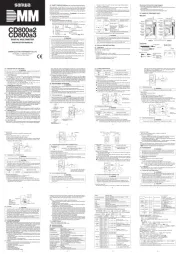
22 Juni 2025
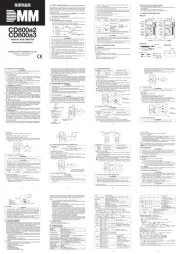
22 Juni 2025
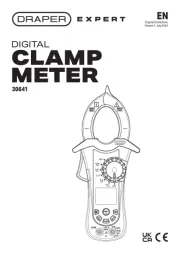
7 Juni 2025
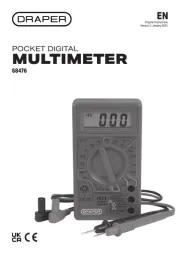
4 Juni 2025
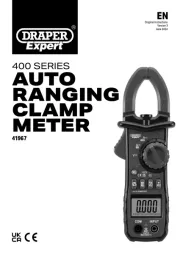
3 Juni 2025
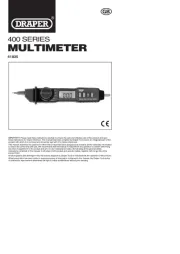
2 Juni 2025
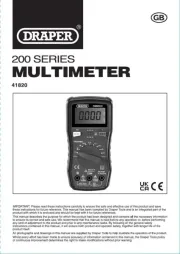
30 Mei 2025
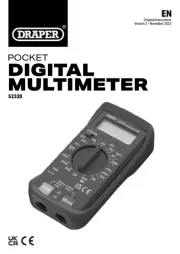
30 Mei 2025
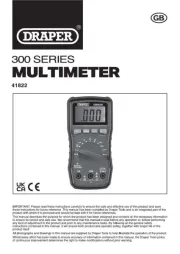
30 Mei 2025